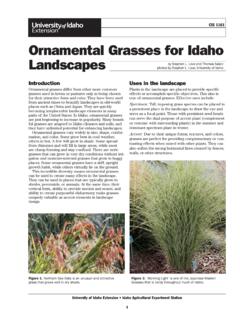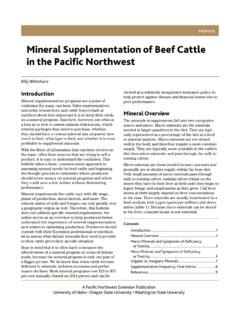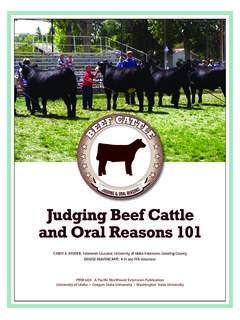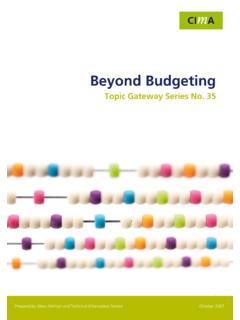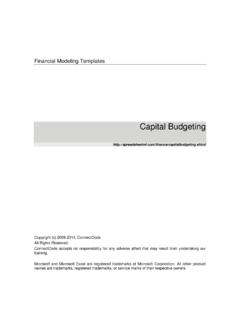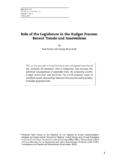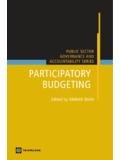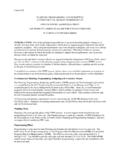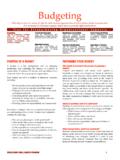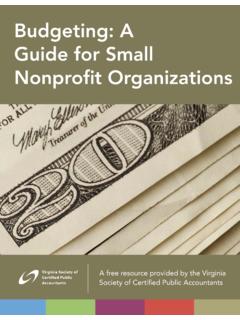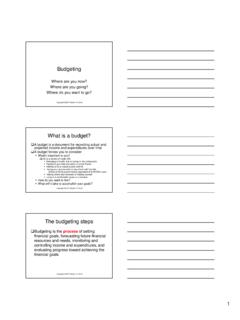Transcription of Understanding budgets and the budgeting process
1 ALTERNATIVE AGRICULTURAL ENTERPRISES PRODUCTION, MANAGEMENT & MARKETINGC ooperative Extension System z Agricultural Experiment Station z CIS 945 Understanding budgetsand the budgeting processR. L. SmathersAs a business owner, the primary problem you face isa limited supply of resources land, labor, andcapital available to accomplish your goals. Allocatingthese scarce resources entails making many decisions might include: What should I growthis year? How much fertilizer should I apply?Should I replace my worn-out tractor? Should Iexpand by purchasing or renting additional land? Theanswers to these questions could influence theprofitability of your operation for years to of the scope of the issue being considered,you must sit down with pencil and paper and analyzethe question. budgeting does just that; budgetingcoordinates resources, production, and is implementing a business on paper before anyresources are committed to production; it helps youpredict the consequences of an adjustment in youroperation before ever making the adjustment.
2 Whilefarm records serve as a record of the past, budgets arean anticipation of the future. After budgets are done,they become a standard for monitoring what actuallyhappens in the usefulness of a budget depends on the reliabilityof the information used to create the budget . Unrealis-tic estimates of prices, yields, or input quantitieswould lessen the accuracy of the budget and couldpossibly lead to a faulty decision. Sound managementdecisions can be made using budgets , but care mustbe exercised in using only reliable of budgetsThere are four types of budgets that will be discussedhere, each playing a different role in decision budgets most commonly used by agriculturalproducers are whole farm, partial, cash flow, farm budgetThis budget is a summary of expected income,expenses, and profit for the entire farm; it measuresthe physical and financial aspects of the whole uses include comparing profitability of severalfarm plans; determining income potential, debtrepayment capacity and value of the farm or ranch;providing lenders and others with a detailed farmplan for the next year.
3 And helping the operatoranalyze major adjustments in the farm budgetIn contrast to the whole farm budget , the partialbudget measures only returns and expenses thatresult from an adjustment in the farm plan. Thoseaspects of the farm plan not affected by the adjust-ment are left alone in the partial budget the constant factors in the overall operationof your business simplifies the analysis greatly. Youmight use the partial budget to help decide what cropto grow on a small amount of acreage. The partialbudget could also help you decide whether or not tobuy or custom-hire machinery for harvest. The partialbudget is far quicker and easier to construct than awhole farm budget because it measures only a changein the farm flow budgetThis budget is a projection of cash receipts andexpenses for the total business spread over somefuture time period, usually 12 months. The purpose ofthis budget is to determine if available cash andexpected receipts will be sufficient to meet projecteddisbursements.
4 If projected disbursements exceedcash available, then borrowed funds will be necessaryto meet these future demands. The cash flow budgetis needed in negotiating a line of operating credit withyour budgetThe last budget , the enterprise budget , is an estima-tion of all revenues and expenses for a farm or ranchenterprise during one cycle of production. Theenterprise budget is usually developed on a per-acreor per-head basis to allow comparisons amongalternative enterprises. This budget can be used tocompare the profitability of alternative enterprises,assist in development of a marketing plan, negotiatewith the sources of credit, and plan adjustments to theoperation. The enterprise budget also provides baseinformation to construct the whole farm, partial andcash flow budgets . The enterprise budget will bediscussed in greater detail in the following sectionsbecause of its importance in creating other anenterprise budgetThe University of Idaho Cooperative ExtensionSystem publishes enterprise budgets for the majorcrops and livestock produced in Idaho.
5 These budgetsare based on production and input data collectedfrom Idaho farmers and ranchers and informationfrom Extension agents, Extension specialists, andothers familiar with commodity apple budget in Table 1, one of many cropbudgets published by the University of Idaho Collegeof Agriculture, shows how an enterprise budgetshould look. Costs in these budgets are categorized asfixed and variable costs. Variable costs are those itemsthat occur annually and vary with different levels ofproduction, such as fertilizer, chemicals, seed, andhired labor. Fixed costs, often referred to as owner-ship costs, remain the same regardless of the level ofproduction. Once machinery and buildings areacquired, the costs associated with these items areincurred even if production stops. Machinery andbuildings depreciate, taxes and insurance are still due,and interest on capital borrowed to purchase theseassets must still be paid.
6 These costs normally do notvary in one year or an enterprise budget can be a formidabletask because of the amount of information needed. Agood set of farm records can make the task mucheasier. If records are not available, enterprise budgetscan be obtained from most county Extension officesand modified to fit your situation. Costs of produc-tion will differ from one operation to another, soexisting budgets should be used only as you develop an enterprise budget from scratch, it isimportant to sit down and pencil out a schedule ofwhat happens from the beginning of the productionprocess to the end. It s very important to note thetiming and number of operations, quantities of inputsapplied, and estimates of machinery use devoted tothe enterprise. Do this for each costsAfter a schedule or outline has been developed, it stime to quantify and categorize the costs. To estimatea variable cost, simply multiply the projected quantityof each variable input (fertilizer, chemicals, seed, etc.)
7 By the anticipated price per unit. For example, Table 1shows that 30 pounds of nitrogen will be applied toeach acre of apples during the production year. Thistranslates into $ per acre (30 lb x $.25/lb).Other variable costs include fuel, lubricants, and re-pair costs on machinery. These costs are not tradition-ally divided among crop enterprises, but are totalledat the end of the year for income tax reasons. Theseyear-end totals can be allocated among trick is to estimate what percentage of your totalmachinery use is required for each crop example, if your tractor is used 400 hours eachyear and 100 of those hours pertain to the appleenterprise, then 25 percent of the tractor fuel, repairs,and lube costs should be allocated to the appleenterprise. For tillage equipment, hours of annual usemay not be available, so times over the field would beanother way of allocating use.
8 If a piece of equipmentis used solely for one enterprise, then 100 percent ofthe costs should be charged to that you do not have a set of farm records containingrepair and fuel costs, ask your local Extension agentfor a copy of The Costs of Owning and Operating FarmMachinery in the Pacific Northwest, PNW 346, (or writeAgricultural Publications, Idaho Street, University ofIdaho, Moscow, Idaho 83843-4196). Some states alsohave worksheets or computer programs designed tohelp estimate these costs. Idaho has the EnterpriseBudget Worksheet program and Machine Cost for MS/PC DOS operating important variable cost is interest on operat-ing capital. An easy way to approximate this is to sumall variable cash expenses for one production total, assuming this is the amount to be bor-rowed, is divided by the proportion of the year thefunds are borrowed, then multiplied by the prevailinginterest rate.
9 Dividing total capital required by twowould imply that the capital to cover cash variablecosts is borrowed, or averaged, for one half of theyear. Dividing by four would imply that the capital isborrowed for one-fourth of the sure all hired labor is included under variablecosts. Even though some of the labor is owner-supplied and doesn t involve a direct cash outlay, itshould still be accounted for in the budgeting costsFixed or ownership costs cover depreciation, intereston investment, taxes, and insurance expenses oncapital items such as machinery, livestock, buildings,and land. Machinery and buildings lose value due toage, use, and obsolescence, and this loss is known ascost of establishing the apple crop and interest onthose costs over the establishment years ($6,000 peracre) could be viewed as a loan to be paid back overthe 25 production years. In this case, the annualinstallment is $661 per year ($6,000 amortized at 10percent for 25 years) and is listed as a fixed cost in interpretationsThe enterprise budget for apples in Table 1 shows areturn above all costs of $ per acre.
10 Althoughthis return is positive, it may not be the maximumprofit possible from an acre of apples. This enterprisebudget simply represents one point on the productioncurve. There are many different combinations ofinputs that will produce a given enterprise, somemore or less profitable than others. The point is thateach combination reflects a point on the productioncurve, not necessarily the most profitable $ per acre net return shown in Table 1 isoften referred to as profit and can be compared to theestimated profit per acre for alternative crops. It canalso be used to select the most profitable crops and/or crop combinations to zero profit for an enterprise does not imply that theenterprise is a losing proposition. It must not beforgotten that a properly constructed budget like theone in Table 1 accounts for all production costs,including opportunity costs. Note that charges areincluded for all purchased variable inputs, all laborwhether hired or owner-supplied, all capital whetherborrowed or owner-supplied, and land whetherrented or owned.


